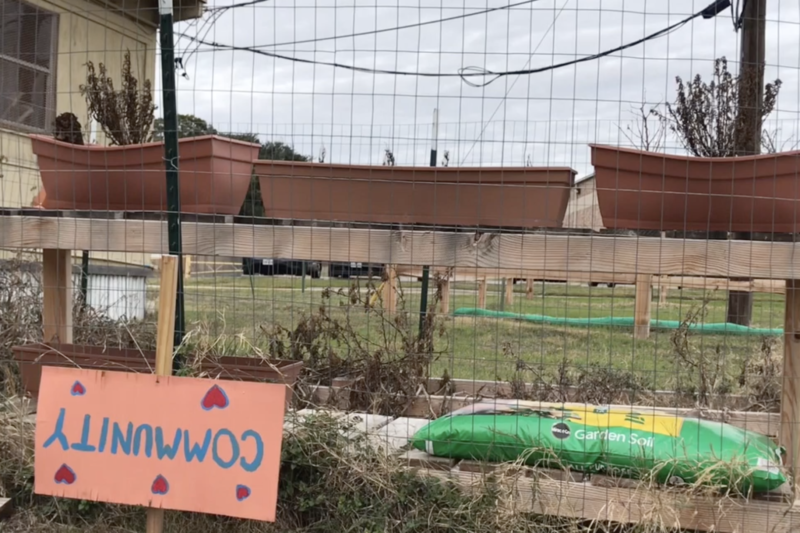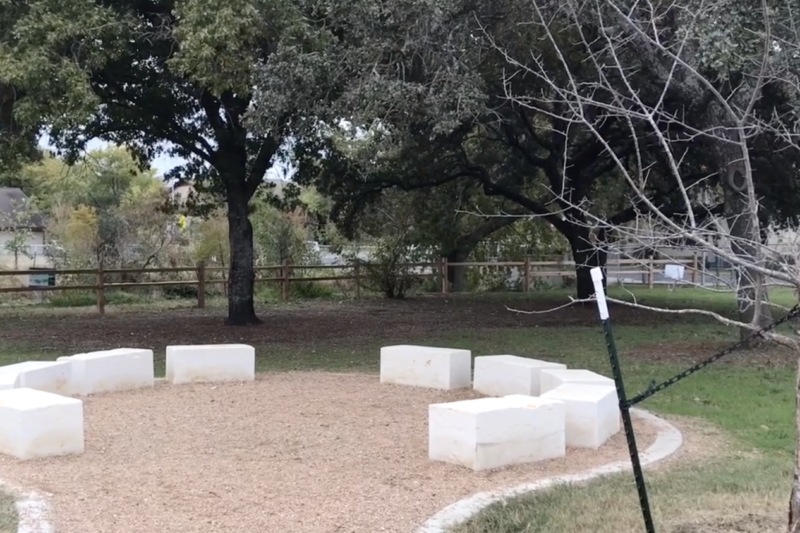Community organizations take new approach to solving Austin neighborhood inequities
By Ruby Shell
Reporting Texas
 Community garden in East Austin is part of a neighborhood effort to enhance quality of life.
Community garden in East Austin is part of a neighborhood effort to enhance quality of life.
Parts of Austin often lack access to expansive green space, are robbed of tree canopy cover surrendered to development and are starved of fresh, healthy foods. But community-based organizations are working to enhance quality of life in these neighborhoods.
This work to preserve these communities is ongoing in the face of new challenges, including gentrification from over-development which leads to rising property values and higher taxes and, for many, displacement.
Despite these challenges, these communities have developed strong relationships and formed tight-knit neighborhoods that still show today.
Go Austin/Vamos Austin, known as GAVA, is a group dedicated to mobilizing community power to reduce barriers to health, while increasing institutional capacity to respond to the people most impacted by historical inequities.
Carmen Llanes Pulido, GAVA’s Executive Director, is focusing on creating a different kind of non-profit in Austin that is more representative of the areas they work in.
“First of all, making sure we have the right people doing the right work at the right time and in the right place. And for me, that’s really been shaping the organization to hire people from the community, to train people as organizers and build upon their strengths and experience,” she said.
The 1928 Master Plan divided Austin along racial lines by limiting community services for African American and Hispanic residents to East Austin. Utilities and public schools are a few that have been leveled against these communities in the past.
Involving people from the community has been a vital component for organizations hoping to make a difference in these areas.
The Children in Nature Collaborative of Austin has also been facilitating conversations surrounding equity in nature.
A branch of the Westcave Discovery Center, near Round Mountain, Texas, CiNCA was formed informally ten years ago by heads of different environmental organizations that wanted to remedy the nature-deficit disorder that mainly children today are experiencing.
The collaborative also wanted to take a different approach to developing a non-profit.
“We use a collective impact model, which focuses on this idea of sharing resources and information so that organizations aren’t in a position to feel like they have to compete with each other,” said Rocío Villalobos, CiNCA program manager for Westcave.
“They’re actually actively working together on initiatives and sharing information to help this movement as a whole,” she said.
CiNCA has recently implemented a new branch of the program called #EquityOutdoorsATX, created as a result of a racial equity summit that was held for outdoor and environmental leadership.
From the summit conversations, Villalobos said there was a big interest in creating a series of workshops and events around racial equity.
“The idea is essentially that race needs to be a constant, ongoing conversation in order for people to feel more comfortable talking about it and thinking about, ‘how is racial equity affecting the work that I’m doing?’” she said.
“My perspective is that the answer is always. If you’re not thinking about that always, that’s how your inequities become ingrained in the work that you’re doing,” she said.
The City of Austin has been working to remedy the children in nature-deficit disorder as well.
The Cities Connecting Children to Nature initiative was established through the city with the goal of ensuring that children all over Austin have equal opportunities to play, learn and grow in nature.
CCCN works closely with the collaborative to organize workshops, programs and activities that aim to remedy this inherent problem.
One of these is the Green School Parks initiative, which looks at school campuses that are jointly owned by the city and Austin Independent School District to develop a park and other outdoor elements and learning spaces that the school as well as the community can access.
 Park improvements, including newly planted trees and trails reflect community efforts in East Austin
Park improvements, including newly planted trees and trails reflect community efforts in East Austin
“The Rundberg area was selected as the first area that we were going to focus these efforts on, because it met all of the different criteria,” said Melody Alcazar, program coordinator for CCCN. “Barrington Elementary and Wooldridge Elementary were our two pilot schools that were identified, and we really spent a lot of our energy at those sites.”
The Rundberg area, located in North Austin, has been the focus of police efforts to improve safety and reduce crime. In 2012, the Austin Police Department received a $1 million grant from the U.S. Department of Justice to build the capacity of the community to deter future crime by addressing a variety of social impacts.
It also is the second most populated area of Austin after downtown, allowing it to meet the criteria for the Green School Parks initiative, which calls for areas that have low access to nature and a high population, said Alcazar.
Ashley Valadez, a third grade teacher at Wooldridge Elementary, teaches English as a second language.
Seventy percent of students at Wooldridge are English language learners, and almost 87% are Hispanic. Additionally, 94.5% are economically disadvantaged.
Since the installation of the park, which will be entirely complete by 2020, Valadez said that having the students outside and interacting with the different play elements has contributed to more positive behavior in the classroom.
“To see them interacting with the outdoor learning space, the creek and the logs that are out there really has shown that they’re aware of these different elements and how to use them,” she said. “It’s been really cool to see them interact well with nature itself, not just playing tag or something.”
Villalobos says that oftentimes teachers want to use the spaces, but they don’t know how or don’t have a personal connection to nature, so activating the space by training teachers and after school programs to utilize it is another vital step.
“The nice thing is that with constant evolution of this, it always provides us with a new and different way to connect children and families to nature,” said Alcazar.
Most importantly, however, is involving the people that need help in the process.
In order to adequately address these issues and find solutions, Villalobos said that involving the community in the process is the most crucial step.
“We have to center those voices and elevate the leaders that are already talking about this work and doing this work,” she said, “so that actions and steps that are taken are led by folks that are directly affected by that.”
Photos and social media by Julie Garcia
East Austin Park Rights Neighborhood Inequities